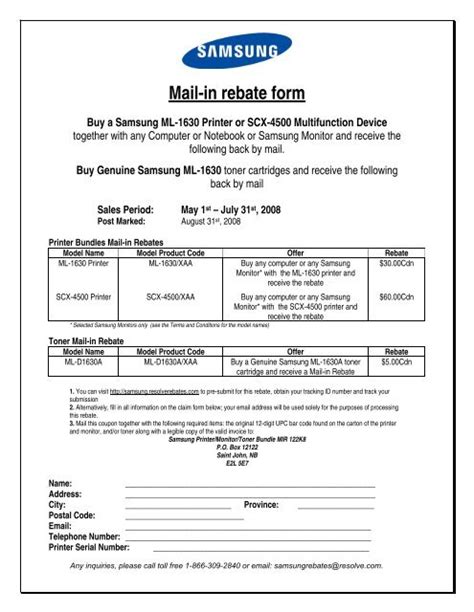Unlocking Savings: Your Guide to the Federal Mail-In Rebate
In an increasingly digital world, the concept of savings often takes a backseat to convenience. However, traditional methods of saving money, such as mail-in rebates, remain a viable option to help you alleviate costs on everyday purchases. This guide will delve into the ins and outs of the federal mail-in rebate, offering you a comprehensive understanding of how it works and how you can unlock potential savings.
What is a Federal Mail-In Rebate?
A federal mail-in rebate is a cash-back incentive offered by companies on products or services that are purchased. After making a qualifying purchase, consumers can send in a form with their receipt to receive a predetermined amount of money back. Unlike instant rebates, which reduce the purchase price at the time of sale, mail-in rebates require a little patience but can lead to significant savings.
Understanding How It Works
To take advantage of a federal mail-in rebate, follow these straightforward steps:
- Research: Look for products with available mail-in rebates. Most brands advertise these deals through flyers, websites, or in-store signage.
- Purchase: Buy the qualifying product, ensuring that you keep your receipt as proof of purchase.
- Fill Out the Rebate Form: Obtain the rebate form, usually found online or at the point of sale, and fill it out accurately.
- Submit Your Claim: Mail the completed form along with the receipt to the address provided. Ensure all documentation is sent before the deadline mentioned on the form.
- Wait for Your Rebate: Once your claim is processed, which can take several weeks, you will receive your rebate via check or electronic transfer.
The Benefits of Mail-In Rebates
Though mail-in rebates may seem outdated in an age of digital transactions, they come with several benefits:
- Significant Savings: Depending on the product, rebates can range from a few dollars to substantial amounts, perfect for budget-conscious consumers.
- Encourages Spending: Some consumers may be more likely to purchase higher-end products when they know they can get a portion of their money back through a rebate.
- Easy to Track: Many companies offer online tracking for contest submissions, allowing consumers to see the status of their rebate claims.
Common Pitfalls to Avoid
While mail-in rebates can be beneficial, there are some common pitfalls that could hinder your ability to save:
- Missing Deadlines: One of the most common reasons rebate claims are denied is due to late submissions. Always check and adhere to deadlines!
- Incomplete Forms: Ensure that you fill out the form fully and accurately. Missing information could delay or void your rebate.
- Not Keeping Copies: Always keep copies of your completed forms and receipts until you’ve received your rebate.
Maximizing Your Savings
To get the most out of mail-in rebates, consider these strategies:
- Stack Discounts: Look for additional offers like coupons or sales that can be combined with your rebate for even greater savings.
- Sign Up for Alerts: Follow your favorite brands on social media or subscribe to newsletters to stay informed about new mail-in rebates.
- Make Purchases in Bulk: If possible, buy in bulk to increase the total rebate amount. Just ensure you have the funds to cover the initial cost.
Conclusion
Mail-in rebates certainly retain their place as a valuable method for savvy shoppers to unlock substantial savings on their purchases. While they require some additional effort through form filling and timing, the cash-back offers they provide can be well worth the investment. By staying informed, organized, and proactive, you can maximize your savings through federal mail-in rebates and enjoy a more cost-effective shopping experience.
FAQs
1. How long does it take to receive a mail-in rebate?
Processing times can vary by company, but typically, you can expect to receive your rebate within 6 to 8 weeks after your submission is processed.
2. Can I submit multiple rebate claims for the same product?
Generally, your claim can only be submitted once per offer unless specified otherwise. Always read the terms and conditions associated with the rebate.
3. What happens if my rebate claim is denied?
If your rebate claim is denied, check the reason given and rectify any issues. You may have the opportunity to resubmit your claim if it was rejected due to a simple error.
4. Are there any fees associated with mail-in rebates?
Typically, there should be no fees associated with submitting a mail-in rebate. However, ensure you keep a record of postage for your submission.
5. Are there any risks involved with mail-in rebates?
The main risks involve the possibility of losing your submission or having your claim denied due to inaccuracy. Keeping copies and following instructions carefully should mitigate these risks.
Download Federal Mail In Rebate
